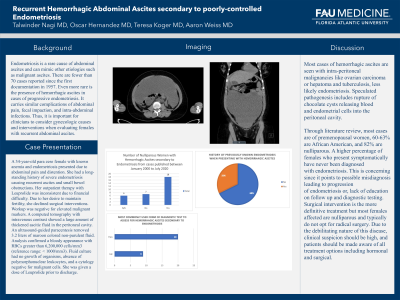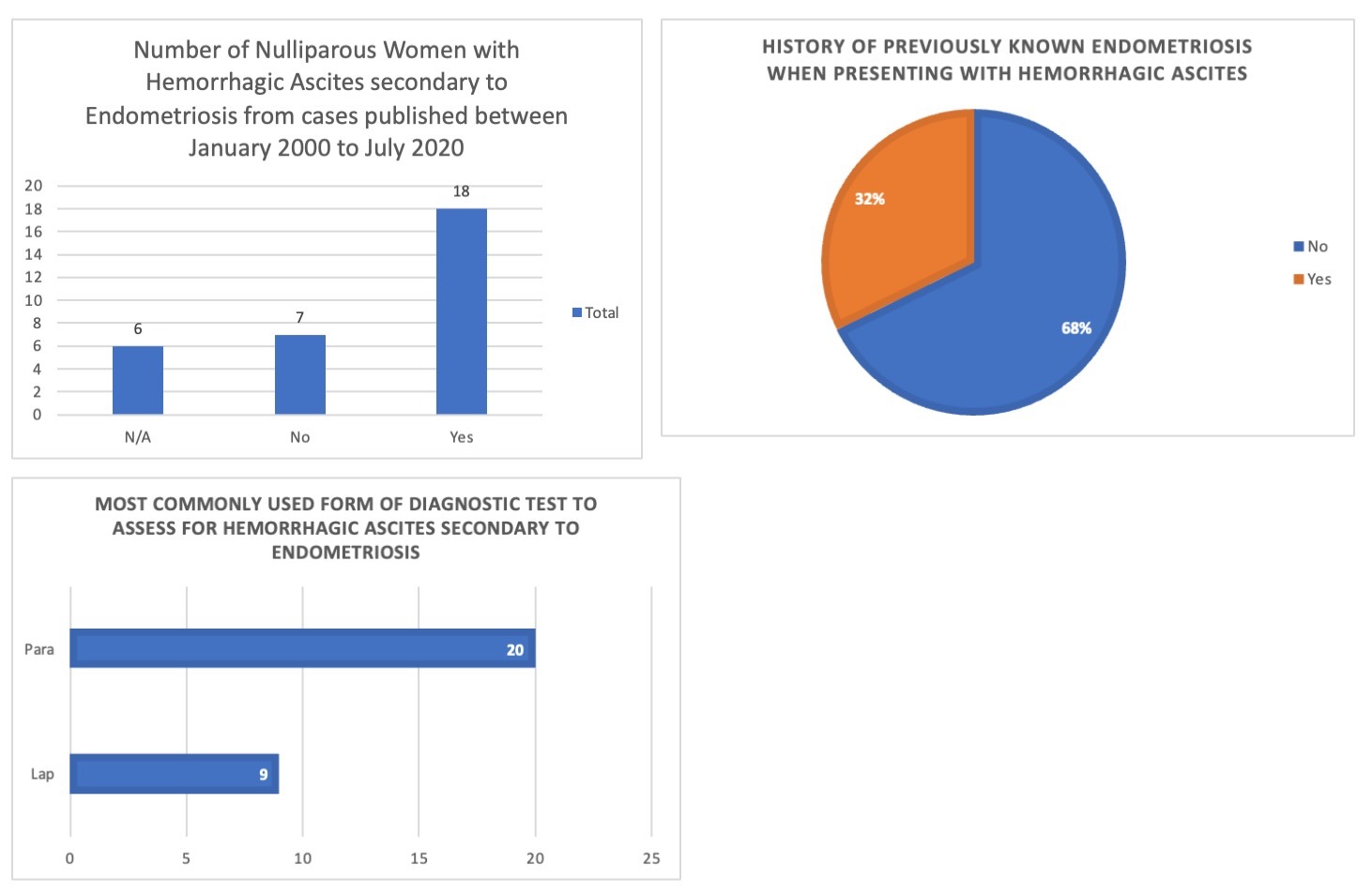Tuesday Poster Session
Category: Liver
P3985 - Recurrent Hemorrhagic Abdominal Ascites Secondary to Poorly-Controlled Endometriosis
Tuesday, October 24, 2023
10:30 AM - 4:00 PM PT
Location: Exhibit Hall

Has Audio

Talwinder Nagi, MD
Florida Atlantic University Charles E. Schmidt College of Medicine
Boca Raton, FL
Presenting Author(s)
Talwinder Nagi, MD1, Oscar Hernandez, MD1, Teresa Koger, MD2, Aaron Weiss, MD3
1Florida Atlantic University Charles E. Schmidt College of Medicine, Boca Raton, FL; 2Florida Atlantic University, Boca Raton, FL; 3Gastro Health, Boca Raton, FL
Introduction: Endometriosis is a rare cause of abdominal ascites and can mimic other etiologies such as malignant ascites. There are fewer than 70 cases reported since the first documentation in 1957. Even more rare is the presence of hemorrhagic ascites in cases of progressive endometriosis. It carries similar complications of abdominal pain, fecal impaction, and intra-abdominal infections. Thus, it is important for clinicians to consider gynecologic causes and interventions when evaluating females with recurrent abdominal ascites.
Case Description/Methods: A 34-year-old para zero female with known anemia and endometriosis presented due to abdominal pain and distention. She had a long-standing history of severe endometriosis causing recurrent ascites and small bowel obstructions. Her outpatient therapy with Leuprolide was inconsistent due to financial difficulty. Due to her desire to maintain fertility, she declined surgical interventions. Workup was negative for elevated malignant markers. A computed tomography with intravenous contrast showed a large amount of thickened ascitic fluid in the peritoneal cavity. An ultrasound-guided paracentesis removed 3.2 liters of maroon colored non-purulent fluid. Analysis confirmed a bloody appearance with RBCs greater than 6,200,000 cells/mm3 (reference range: < 1000/mm3). Fluid culture had no growth of organisms, absence of polymorphonuclear leukocytes, and a cytology negative for malignant cells. She was given a dose of Leuprolide prior to discharge.
Discussion: Most cases of hemorrhagic ascites are seen with intra-peritoneal malignancies like ovarian carcinoma or hepatoma and tuberculosis, less likely endometriosis. Speculated pathogenesis includes rupture of chocolate cysts releasing blood and endometrial cells into the peritoneal cavity. Through literature review, most cases are of premenopausal women, 60-63% are African American, and 82% are nulliparous. A higher percentage of females who present symptomatically have never been diagnosed with endometriosis. This is concerning since it points to possible misdiagnosis leading to progression of endometriosis or, lack of education on follow up and diagnostic testing. Surgical intervention is the more definitive treatment but most females affected are nulliparous and typically do not opt for radical surgery. Due to the debilitating nature of this disease, clinical suspicion should be high, and patients should be made aware of all treatment options including hormonal and surgical.

Disclosures:
Talwinder Nagi, MD1, Oscar Hernandez, MD1, Teresa Koger, MD2, Aaron Weiss, MD3. P3985 - Recurrent Hemorrhagic Abdominal Ascites Secondary to Poorly-Controlled Endometriosis, ACG 2023 Annual Scientific Meeting Abstracts. Vancouver, BC, Canada: American College of Gastroenterology.
1Florida Atlantic University Charles E. Schmidt College of Medicine, Boca Raton, FL; 2Florida Atlantic University, Boca Raton, FL; 3Gastro Health, Boca Raton, FL
Introduction: Endometriosis is a rare cause of abdominal ascites and can mimic other etiologies such as malignant ascites. There are fewer than 70 cases reported since the first documentation in 1957. Even more rare is the presence of hemorrhagic ascites in cases of progressive endometriosis. It carries similar complications of abdominal pain, fecal impaction, and intra-abdominal infections. Thus, it is important for clinicians to consider gynecologic causes and interventions when evaluating females with recurrent abdominal ascites.
Case Description/Methods: A 34-year-old para zero female with known anemia and endometriosis presented due to abdominal pain and distention. She had a long-standing history of severe endometriosis causing recurrent ascites and small bowel obstructions. Her outpatient therapy with Leuprolide was inconsistent due to financial difficulty. Due to her desire to maintain fertility, she declined surgical interventions. Workup was negative for elevated malignant markers. A computed tomography with intravenous contrast showed a large amount of thickened ascitic fluid in the peritoneal cavity. An ultrasound-guided paracentesis removed 3.2 liters of maroon colored non-purulent fluid. Analysis confirmed a bloody appearance with RBCs greater than 6,200,000 cells/mm3 (reference range: < 1000/mm3). Fluid culture had no growth of organisms, absence of polymorphonuclear leukocytes, and a cytology negative for malignant cells. She was given a dose of Leuprolide prior to discharge.
Discussion: Most cases of hemorrhagic ascites are seen with intra-peritoneal malignancies like ovarian carcinoma or hepatoma and tuberculosis, less likely endometriosis. Speculated pathogenesis includes rupture of chocolate cysts releasing blood and endometrial cells into the peritoneal cavity. Through literature review, most cases are of premenopausal women, 60-63% are African American, and 82% are nulliparous. A higher percentage of females who present symptomatically have never been diagnosed with endometriosis. This is concerning since it points to possible misdiagnosis leading to progression of endometriosis or, lack of education on follow up and diagnostic testing. Surgical intervention is the more definitive treatment but most females affected are nulliparous and typically do not opt for radical surgery. Due to the debilitating nature of this disease, clinical suspicion should be high, and patients should be made aware of all treatment options including hormonal and surgical.

Figure: Analysis of systematic review completed by Pandraklakis on 32 patients documented in literature with hemorrhagic ascites secondary to endometriosis from January 2000 to July 2020
Disclosures:
Talwinder Nagi indicated no relevant financial relationships.
Oscar Hernandez indicated no relevant financial relationships.
Teresa Koger indicated no relevant financial relationships.
Aaron Weiss indicated no relevant financial relationships.
Talwinder Nagi, MD1, Oscar Hernandez, MD1, Teresa Koger, MD2, Aaron Weiss, MD3. P3985 - Recurrent Hemorrhagic Abdominal Ascites Secondary to Poorly-Controlled Endometriosis, ACG 2023 Annual Scientific Meeting Abstracts. Vancouver, BC, Canada: American College of Gastroenterology.
